IC-IMPACTS 2015 Graduate Summer Institute In Optical Sensing Technologies
Advancing Knowledge and Inspiring Entrepreneurship
The IC-IMPACTS Summer Institute is an annual interdisciplinary program designed to equip Canadian and Indian graduate students with an awareness of cutting-edge research, inspire students to develop entrepreneurial mindsets, and develop their science communication, networking, and commercialization skills. Held at the University of Toronto in June 2015, the inaugural Summer Institute focused on optical sensing technologies spanning infrastructure, water, and public health fields.
In total 47 graduate students from 29 Canadian and Indian academic institutions and 18 disciplines participated in the Institute.
Over the course of the week-long program, students learned cutting-edge research techniques from leading experts in the optical sensing field, viewed demonstrations to show how these research techniques are applied in community contexts, and presented their own scientific research. In addition, students were challenged to think about how their own research could directly benefit communities and society.
In collaboration with the University of Toronto’s Impact Centre, students worked in teams to identify and create solutions for major contemporary health problems. Through interactive, team projects, they learned together how to think of research not as technology but as something of benefit to others and then to imagine a solution that could become a useable product in a community. Equally important to being exposed to the latest research advances in sensing and developing enhanced entrepreneurship and commercialization skills, the participants left the Summer Institute with a rich and expanded network of friendships between Canada and India that will last a lifetime.
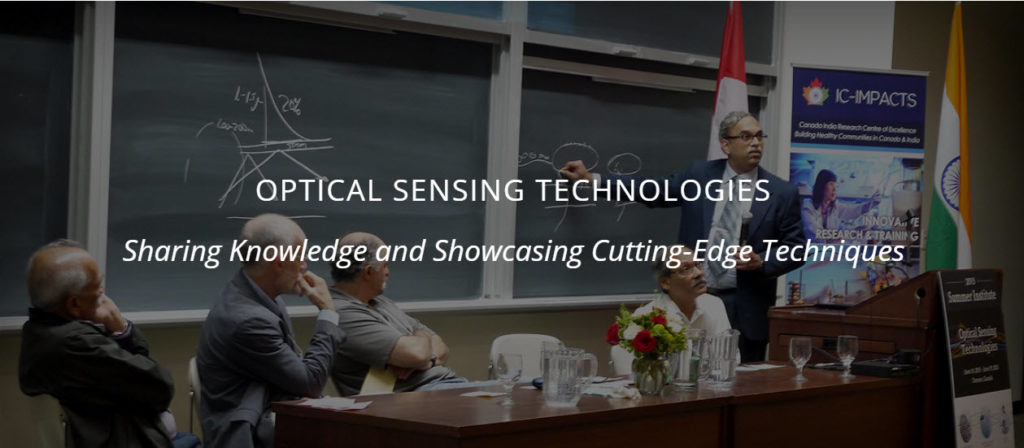 Optical Sensing Technologies
Optical Sensing Technologies
Sharing Knowledge and Showcasing Cutting-Edge Techniques
As a relatively new area of research, optical sensing and other light based technologies can help provide accurate, real-time information across a variety of fields for increased safety and greater sustainability. With research in distributed fiber optic sensors progressing quickly, a variety of low-cost sensors can be created to measure vibration, stress, temperature and pressure within civil infrastructure. “The data [generated by sensors] is significant when high precision measurements for [critical infrastructure such as] damns, pipelines, power generators and aerospace are needed” (Dr. Xiaoyi Bao, Physics Professor at University of Ottawa).
Further, Optical Sensing technologies can help identify deep cracks in infrastructure as they begin to form, allowing proper prevention techniques to be applied much earlier. Dr. Nemy Banthia, Professor, Distinguished University Scholar & Canada Research Chair in Infrastructure Rehabilitation at the The University of British Columbia helped bring some perspective on these technological advancements. “In Canada, infrastructure is designed to last 100 years, yet the average lifespan of infrastructure is only 37 years,” he stated. With reduced lifespans and aging infrastructure across Canada and India, the opportunity for the application of sensor technologies are significant.
In the water sector, Dr. Thallapil Pradeep from the Indian Institute of Technology Madras showed students how advanced light based technologies were being used to remove arsenic from contaminated water sources. “By creating filters that use silver nanoparticles with anti-microbial properties, one filter could provide a family of clean water for an entire year in India,” he said.
By creating filters that use silver nanoparticles with anti-microbial properties, one filter could provide a family of clean water for an entire year in India.
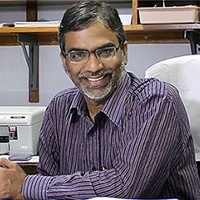 – Dr. Thallapil Pradeep, IIT Madras
– Dr. Thallapil Pradeep, IIT Madras
Health applications of sensing technologies were also explored. With many new research techniques being taught, Dr. Edith Hilan encouraged students to look at the bigger picture. “You can’t just throw technology at the solution, you also need to think about the culture it would be applied to,” she noted. “Vaccines can’t help a community if electricity is not available to refrigerate the vaccines. We need to think of how our research intersects with communities.”
Over the course of the Institute, students were exposed to cutting-edge ideas through presentations and interactive panel discussions with some of Canada and India’s most innovative minds, including Professor Jacques Albert (Carleton University), Dr. M.R. Shenoy (IIT Delhi), Dr. Simarjeet Saini (University of Waterloo), Dr. Soumyo Mukherji (IIT Bombay), Dr. Mina Hoorfar (The University of British Columbia), (Professor Tapanendu Kundu (IIT Bombay), Dr. Mo Mojahedi (University of Toronto), Dr. Pierre Berini (University of Ottawa), and Professor Arun Kumar (IIT Delhi).
“Moving from Lab to Field”
State-of-the-art laboratory research was paired with hands-on interactions during the Summer Institute. A number of researchers demonstrated their sensing technologies to showcase how these techniques can be applied within community contexts. Dr. Michael Serpe from the University of Alberta showed the students how to construct sensors in the field. Many of the students were not expecting to be coating real surfaces with actual polymers, and were surprised at how these devices could be constructed.
Dr. Robert Andrews from the University of Toronto provided a detailed tour of his drinking water research lab on campus. He and his team showcased how they analyze water samples and what state-of-the-art equipment is being used to ensure water sources remain clean.
In addition, Ms. Evangeline Murison (Manitoba Infrastructure and Transportation), Dr. James Dou (ChipCare Corp.), Dr. V. Ramgopal Rao (NanoSniff Technologies) and Dr. Sumohana Channappayya (IIT Hyderabad) all presented their experiences of applying their scientific research to affect real change in communities.
We’re capturing students early on in their studies to get them to think about how to commercialize their technologies. The sooner we can train students to think like entrepreneurs the better.
 – Dr. Michael Serpe , University of Alberta
– Dr. Michael Serpe , University of Alberta
“Communicating Research”
Having learned from the experts, the students were challenged to find ways of presenting their own science. Through a rapid-fire presentation approach, students were each given 5 minutes to make oral presentations about their own research and present it through 3 powerpoint slides. The student themselves evaluated the presentations of their peers, judging based on the complexity and value of the science, the clarity and visual communication, and overall innovation. Expert researchers also served as an adjudicating committee and together with the input from student peer evaluations, the top presenters were recognized. Top place went to Christina Grace Charlet C (IIT Madras) and a tie for second place was awarded to Kevin Joseph (University of Toronto) and Bhuvaneshwari Karunakaran (IIT Bombay).
Fostering Entrepreneurship
“You Don’t Sell Technology, You Sell Products”

The Summer Institute challenged students to think beyond research and to acquire the mindset and skills to become successful entrepreneurs. In partnership with the Impact Centre at the University of Toronto, students explored how their technologies could grow beyond laboratory science and truly benefit society.
“Revolutionary products come from breakthrough science,” noted Dr. Cynthia Goh, Director of the Impact Centre. Throughout the Summer Institute, she and her team worked with students to inspire them to identify a health challenge confronting citizens, invent a new product to address the challenge, and to acquire the entrepreneurship skills of building a business plan, assessing the target audience, and planning how to take their solution to market.
Once all of the challenges had been suggested, the group voted on their favourite problems and formed teams around the challenges, ensuring each team had a mix of Canadian and Indian students. Throughout the week, the students learned how to create business models, structure a company, create value propositions and apply for intellectual property. The Impact Centre then worked with each group to help form their pitch and refine their presentation skills.
They’re putting a lot of effort in how to present not just the science that they’re working on, but a complete picture on where this work might be useful.
 – Emanuel Istrate, Impact Centre at University of Toronto
– Emanuel Istrate, Impact Centre at University of Toronto
The ideas that emerged from the teams were original and exciting. New products were proposed including polarized lenses recycled from 3D glasses to combat high beams during night time driving, colour changing paper to reflect E. coli levels in a public restroom, innovative filters to combat second hand smoke to name just a few. Each solution showcased engineered concepts, manufacturing processes, and business models for financial stability.
Srishti Banerji (Concordia University), Monika Puniya (IIT Varanasi), Vinodh Caralapatti (Concordia University), and Bhuvaneshwari Karunakaran (IIT Bombay) pitched a novel biodegradable “cover” that would limit the amount of second-hand smoke released from a cigarette. With an intriguing design, and a solid business around the product, the team members were all given awards for their excellence in creativity and collaboration.
Before coming here I didn’t think that I would launch any company but now I really think that if any of my idea could have potential commercialization I would definitely launch it by myself.
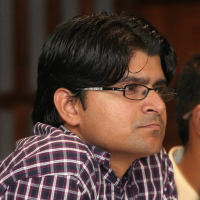 – Ravi Kant Upadhyay, Shiv Nadar University
– Ravi Kant Upadhyay, Shiv Nadar University
After an intense week, the participants came away with new research and communication skills, as well as an expanded network of students and professors across two nations. If an opportunity like this is of interest to you, please sign up for our newsletter below and stay tuned as dates and research themes are announced for next year’s Summer Institute, held in Edmonton, Canada at the University of Alberta.

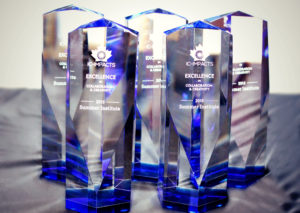
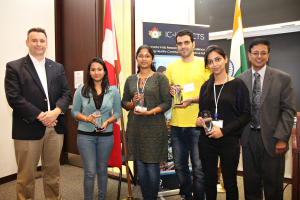

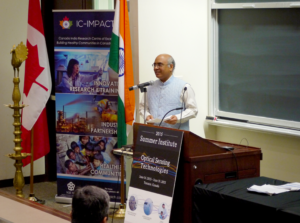
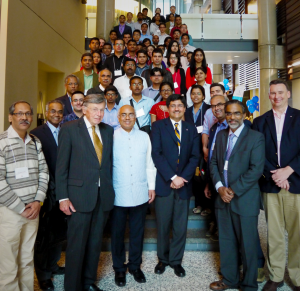
 Optical Sensing Technologies
Optical Sensing Technologies – Dr. Thallapil Pradeep, IIT Madras
– Dr. Thallapil Pradeep, IIT Madras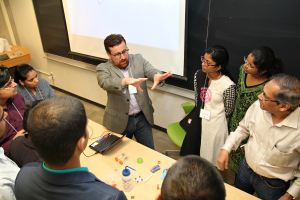
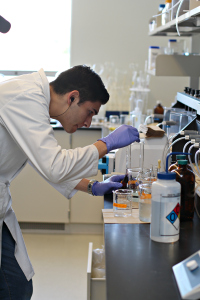

 – Dr. Michael Serpe , University of Alberta
– Dr. Michael Serpe , University of Alberta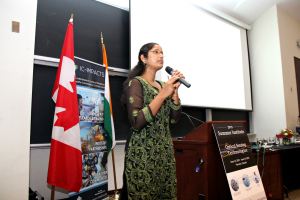
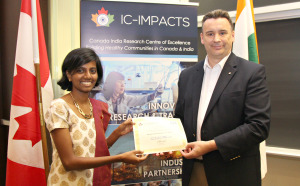
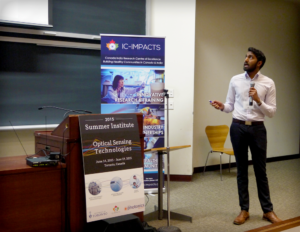
 The Summer Institute challenged students to think beyond research and to acquire the mindset and skills to become successful entrepreneurs. In partnership with the Impact Centre at the University of Toronto, students explored how their technologies could grow beyond laboratory science and truly benefit society.
The Summer Institute challenged students to think beyond research and to acquire the mindset and skills to become successful entrepreneurs. In partnership with the Impact Centre at the University of Toronto, students explored how their technologies could grow beyond laboratory science and truly benefit society.

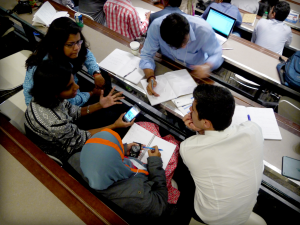 The students devised extremely innovative solutions to the challenge choosing an incredibly diverse range of health-challenge topics. These ranged from frozen eyelashes affecting vision in cold climates, difficulty with heavy breathing in cold winter months, overheating of electronics due to hot weather, the transfer of diseases through public restrooms and difficulty driving at night due to oncoming high beams from vehicles.
The students devised extremely innovative solutions to the challenge choosing an incredibly diverse range of health-challenge topics. These ranged from frozen eyelashes affecting vision in cold climates, difficulty with heavy breathing in cold winter months, overheating of electronics due to hot weather, the transfer of diseases through public restrooms and difficulty driving at night due to oncoming high beams from vehicles. – Emanuel Istrate, Impact Centre at University of Toronto
– Emanuel Istrate, Impact Centre at University of Toronto – Ravi Kant Upadhyay, Shiv Nadar University
– Ravi Kant Upadhyay, Shiv Nadar University

